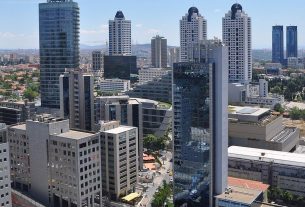In the global race to combat climate change, carbon removal technologies are emerging as a critical tool in the fight against rising greenhouse gas emissions. One innovative solution making waves is “Carbon Casting,” a cutting-edge technology developed by Graphyte, a startup backed by notable investors, including Bill Gates. The technology, which aims to accelerate the removal of carbon dioxide (CO2) from the atmosphere, has caught the attention of environmentalists, scientists, and entrepreneurs alike for its potential to scale and mitigate the worst impacts of climate change.
Barclay Rogers, the CEO of Graphyte, is at the forefront of this groundbreaking innovation. In a recent interview, Rogers discussed the details of the Carbon Casting process, how it works, and why it holds promise as a sustainable solution for carbon removal. In this article, we explore what Carbon Casting is, how it works, and why it could be a game-changer in the fight to reduce CO2 levels and achieve net-zero emissions.
What is Carbon Casting?
At its core, Carbon Casting is a direct air capture (DAC) technology designed to extract carbon dioxide (CO2) directly from the atmosphere. Unlike traditional methods of reducing emissions at the point of production, such as renewable energy or efficiency upgrades, Carbon Casting focuses on actively removing existing CO2 from the environment—essentially “cleaning” the air after emissions have already occurred.
The process involves capturing ambient CO2 and turning it into a stable, solid form, where it can be safely stored or used in other industrial applications. Graphyte’s proprietary technology is designed to capture CO2 at a high scale, transforming the captured gas into solid carbon through a process known as mineral carbonation, or “carbon mineralization.” This process occurs naturally over long periods but can be accelerated through Graphyte’s novel system.
By accelerating the mineralization of carbon, Graphyte’s technology has the potential to sequester carbon in a way that is both safe and permanent, effectively removing CO2 from the atmosphere and helping to mitigate global warming.
How Does Carbon Casting Work?
The Carbon Casting process begins by capturing CO2 from the air using advanced filtering and absorption technologies. Once the CO2 is captured, it is then converted into a stable solid form through a chemical reaction with minerals found in abundant, naturally occurring rocks like basalt and other silicate minerals.
The chemical reaction involves reacting CO2 with minerals to create carbonates, which are stable, solid compounds that can be safely stored or used in a variety of industries. The process is inspired by natural weathering processes that occur over thousands of years, but Graphyte’s technology speeds up this reaction to a matter of days or weeks, making it scalable for industrial use.
Graphyte’s approach to carbon removal is unique because it does not rely on land-based storage, such as underground storage reservoirs, which require significant infrastructure and can face regulatory hurdles. Instead, the solidified carbon can be stored in stable geological formations or used in building materials, such as concrete, which could lock the carbon away for decades or even centuries. By incorporating carbon into construction materials, Graphyte could also help create a circular carbon economy, where the captured carbon has an economic value and is reused in a way that avoids additional emissions.
The Role of Bill Gates and Graphyte’s Investment Backing
Bill Gates and his Breakthrough Energy Ventures fund have been pivotal in supporting the development of next-generation clean energy technologies and carbon removal solutions, including Carbon Casting. Gates has long been an advocate for the need to fund innovations that have the potential to scale up quickly and make a significant impact on reducing global carbon emissions.
According to Gates, climate change will not be addressed solely through traditional renewable energy solutions, such as wind or solar power. Technologies that can remove carbon from the atmosphere are just as crucial if humanity is to reach net-zero emissions by mid-century. Gates believes that direct air capture technologies, including Carbon Casting, represent a promising avenue for scaling up carbon removal efforts and addressing emissions that are difficult to eliminate through conventional methods.
Graphyte’s partnership with Breakthrough Energy Ventures has provided the startup with financial backing and access to a network of climate-focused investors and scientists. This support is crucial as the company continues to refine its technology and scale up its operations to address the growing demand for carbon removal solutions.
Why Carbon Casting Is a Game Changer
The scalability and permanence of Carbon Casting make it a potential game-changer in the race to achieve net-zero emissions. While traditional methods of capturing and storing carbon have been limited by cost and technological barriers, Carbon Casting offers several advantages that could allow it to scale quickly:
- High-Volume Carbon Capture: The Carbon Casting technology is designed to capture large amounts of carbon directly from the atmosphere, offering a scalable solution to tackle the massive challenge of reducing CO2 levels.
- Permanence of Carbon Sequestration: Unlike other carbon capture methods that rely on underground storage, the solidified carbon created by Carbon Casting can be permanently stored in a stable form or used in construction materials, making it a long-term solution.
- Cost-Effectiveness: With advanced chemical engineering and natural minerals, Graphyte aims to reduce the cost of carbon removal, making it more economically viable in the long term. As technology matures and economies of scale kick in, it is expected that the costs will further decrease.
- Circular Economy Potential: By converting CO2 into building materials like concrete, Carbon Casting helps reduce the carbon footprint of construction industries, which are traditionally high emitters. This contributes to the creation of a circular carbon economy where captured carbon is used as an industrial resource rather than being stored away.
- Mitigating Hard-to-Abate Emissions: Carbon Casting could play a key role in addressing the emissions from industries that are difficult to decarbonize, such as steel, cement, and aviation. These sectors could utilize captured CO2 for industrial processes or storage, while achieving their own carbon reduction goals.
The Road Ahead: Challenges and Opportunities
While Carbon Casting presents a promising solution, it is not without its challenges. Scaling up the technology and ensuring that it operates efficiently and at a large scale will require significant investment, infrastructure development, and regulatory approval. The process of carbon removal must also be integrated into broader climate policies and carbon markets to ensure that the captured carbon is properly valued and accounted for.
That said, Barclay Rogers and the Graphyte team are optimistic about the future. With Bill Gates’ backing and the increasing global demand for sustainable technologies, Carbon Casting is positioned to play an important role in achieving the world’s climate goals.
Conclusion: A Pivotal Step in the Fight Against Climate Change
The launch of Carbon Casting by Graphyte is a significant step forward in the development of carbon removal technologies. With the backing of Bill Gates and Breakthrough Energy Ventures, this innovative solution has the potential to scale up rapidly and contribute meaningfully to global efforts to combat climate change.
As the world grapples with the growing climate crisis, technologies like Carbon Casting offer a glimpse of hope—proof that with the right innovation and investment, it is possible to address one of the most pressing environmental challenges of our time.
References:
- Graphyte Official Website: “About Carbon Casting.” Graphyte
- Breakthrough Energy Ventures: “Innovations in Carbon Removal.” Breakthrough Energy
- Bill Gates on Carbon Removal: “The Need for Direct Air Capture.” Gates Notes
- International Energy Agency (IEA): “Carbon Capture and Storage.” IEA

